
– It is done, General. Gerboise bleue was a success. We have the bomb… but…
– What is it, Lieutenant Narwhal ?
– The British… it seems they have it as well.
– We cannot accept that, Mon Lieutenant. Make sure we have more bombs than they have. At any cost !
– Yes sir!
– And make them pointy!
NukeWar is the last of the Avalon Hill Summer 1980 I will cover. The game starts in a random year between 1956 and 1965 and puts the player and an AI-controlled nation in an arms race that can only end in one way : nuclear war.
In my case, the game started in 1965. I have 8 cities [C], one fighter-bomber base [B] and one missile silo [M]. Our local brand of anglo-saxons have the same, but all hidden from me :
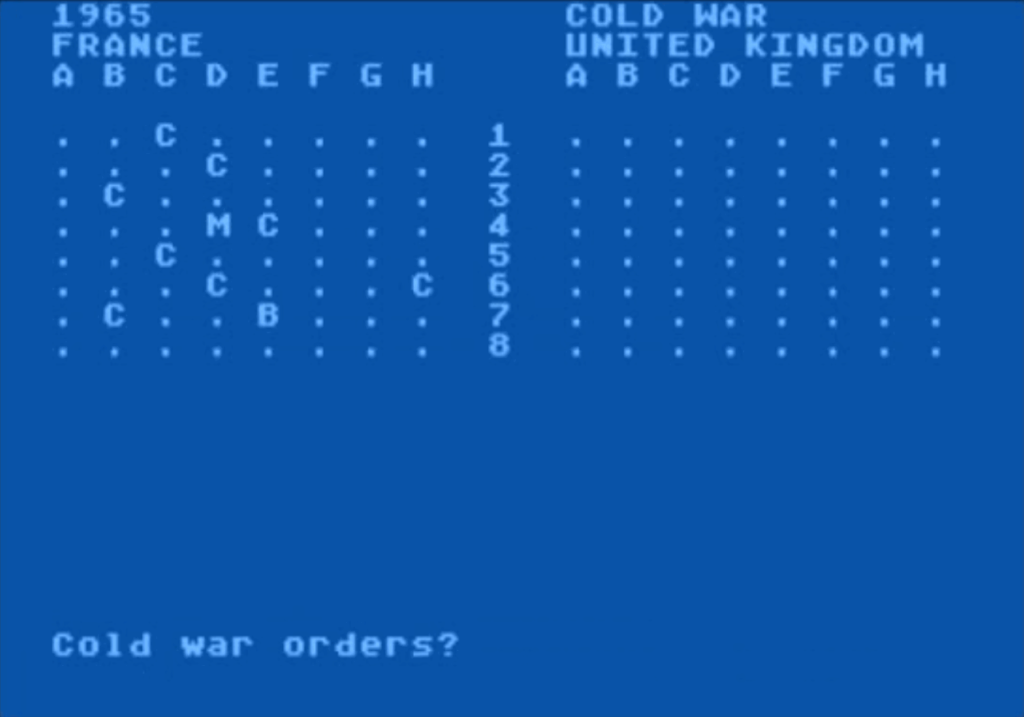
I am given the option to spy on the British, to declare war or to focus on building more forces. I choose the latter, allowing me to build two nuclear assets instead of one, but not giving me much information on the British layout – not that there is a lot to see at this point.
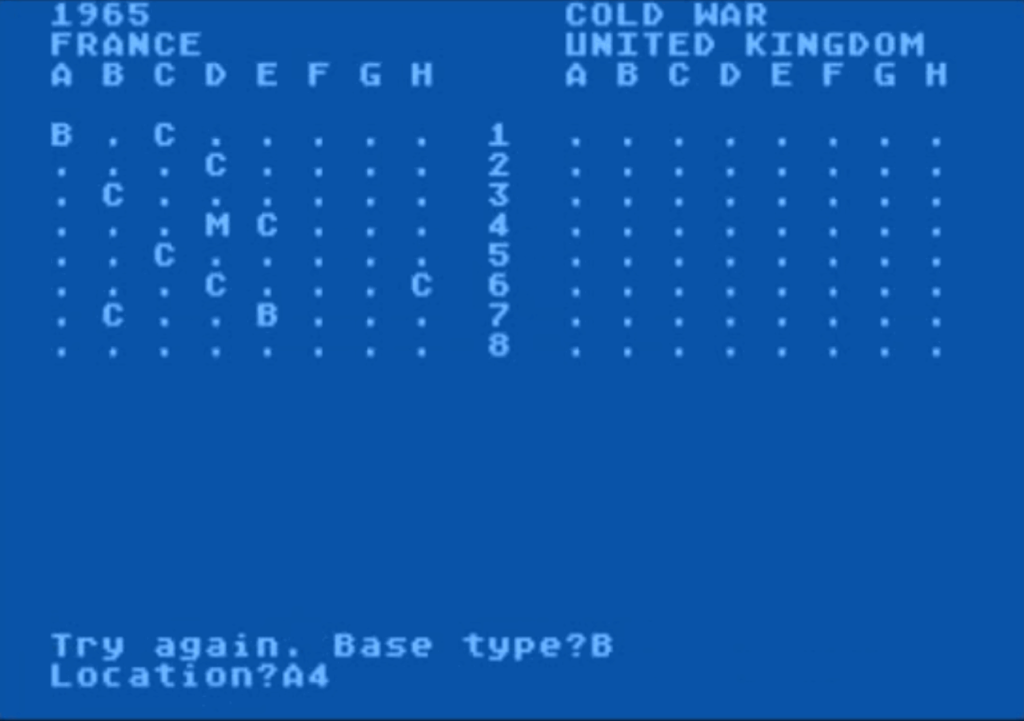
I choose to build fighter-bomber bases initially. When the nuclear war inevitably begins, each fighter-bomber base will generate 1 to 8 fighter-bombers, that I will choose to allocate either as fighters or (nuclear) bombers. I choose fighter-bomber bases for one reason : as the nuclear bombers will fly over enemy territory, they will be able to attack targets that I have not detected which is a real advantage at the beginning of the game when you have very little information on the other country.
Their weaknesses is that they take some time to arrive on target (making them not great for first strike) and that they can be intercepted by enemy fighters.
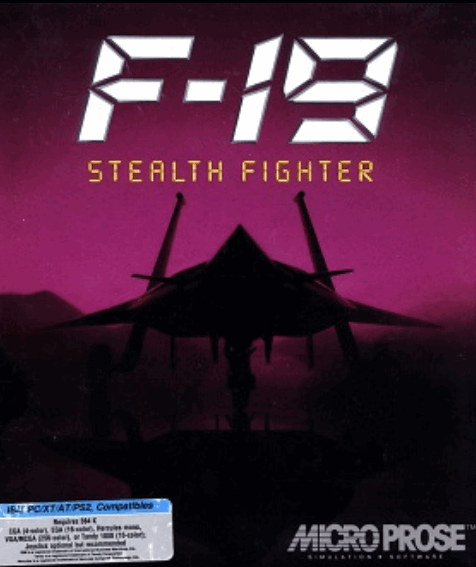
After three years spend building airbases, I decide to switch to missile silos. In case of war, missile silos will launch 1 to 8 nuclear missiles at the enemy. You aim them at an exact coordinate, though they can be a bit inaccurate sometimes. Their arrival is very fast, so they are great to destroy the enemy nuclear capabilities, especially as part of a first strike. Of course, to use them properly, you need information on the enemy layout, so I am now spying our northern neighbors.
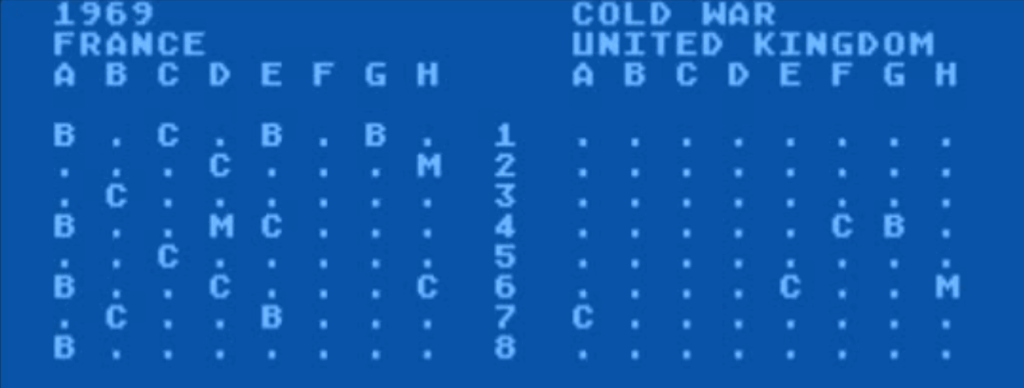
Three years later, I have a better idea of the enemy layout. Since we reached 1970, I can start building anti-ballistic missile batteries [A]. Upon activation, they ready 1 to 8 anti-ballistic missiles [aka as ABM], which have a chance to intercept both missiles and bombers.
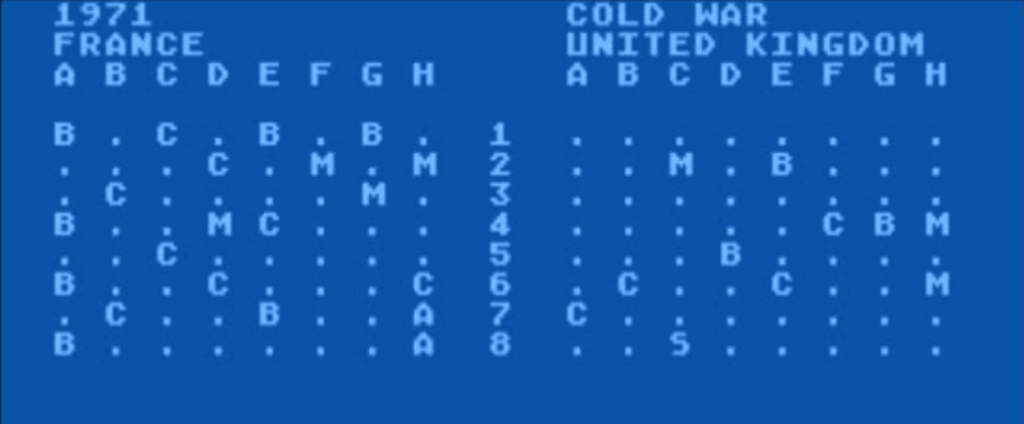
Mathematically, 1-8 missiles or 1-8 anti-missiles seems equivalent, but anti-ballistic missiles are invaluable to dull the enemy first strike, protecting one’s retaliation force.
The years pass, I carry on building missile silos and anti-missile batteries. The United Kingdom has built mostly missiles and bomber bases, in addition to submarine pens [S]. The latter are available starting in 1965 and behave like missile silos, except that upon activation they leave their port and will launch their 1 to 8 missiles later. Their advantage is that they usually automatically leave port at the beginning of the game, protecting them from early strikes, but still I find the missile silos first strike capacity way superior.
In the 1976, the war turned hot, and United Kingdom attacked. Luckily, I had ordered to [S]py , which means they do not get the advantage of a first strike without immediate retaliation ; most of my planes automatically take off.
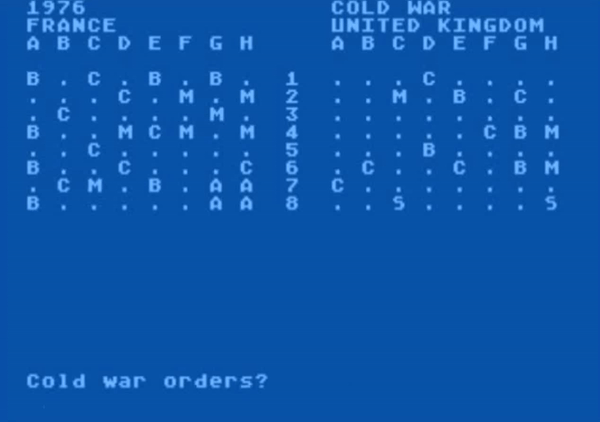
Sadly, my ABM batteries did not activate automatically, so my first presidential calls are for them :

On the other hand, two of my missile silos automatically activate, giving me a total of 15 missiles ! I aim 2 missiles per enemy military installations ignoring the British cities for now. The Brits target two of my cities, one missile silo, one anti-missile battery and two of my airbases – they do not know that my planes have already taken off.
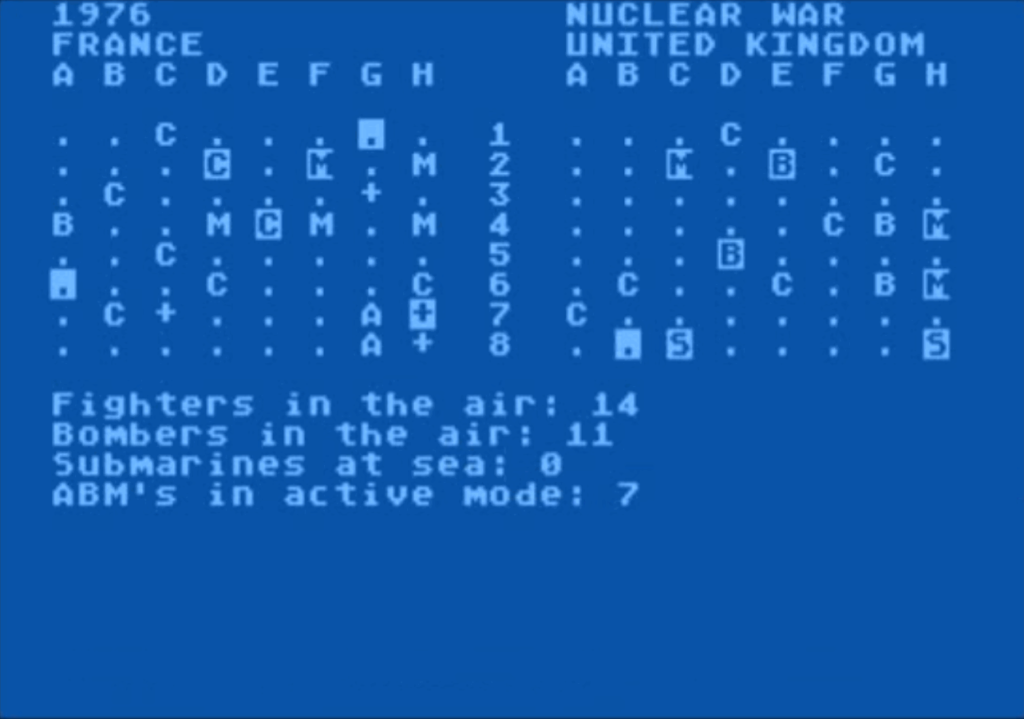
Most of my missiles are intercepted, and only one of theirs is :
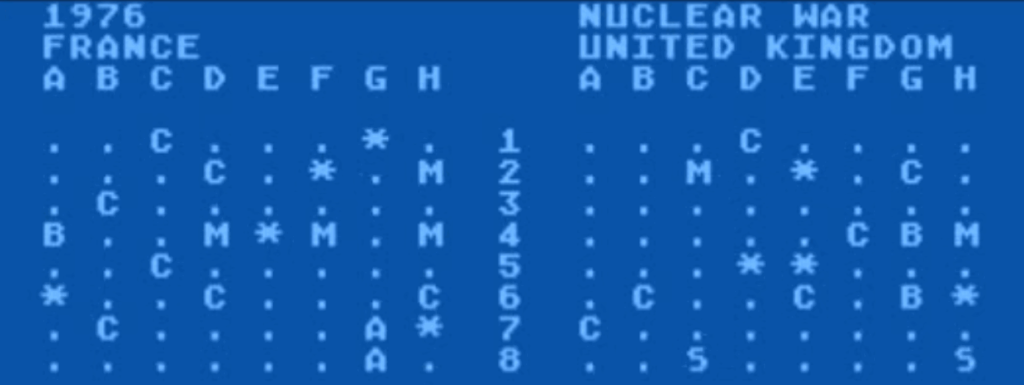
Next “turn” neither of us can activate a lot of things, I put 8 bombers in the air from my last airbase, and one of my silos activates but it only has a couple missiles to allocate.

But the following turn, I get to activate two more silos, again for a total of 15 more missiles. Sadly, the Brits send their own salvo. This is the moment the British Premier chooses to try to stop the war !
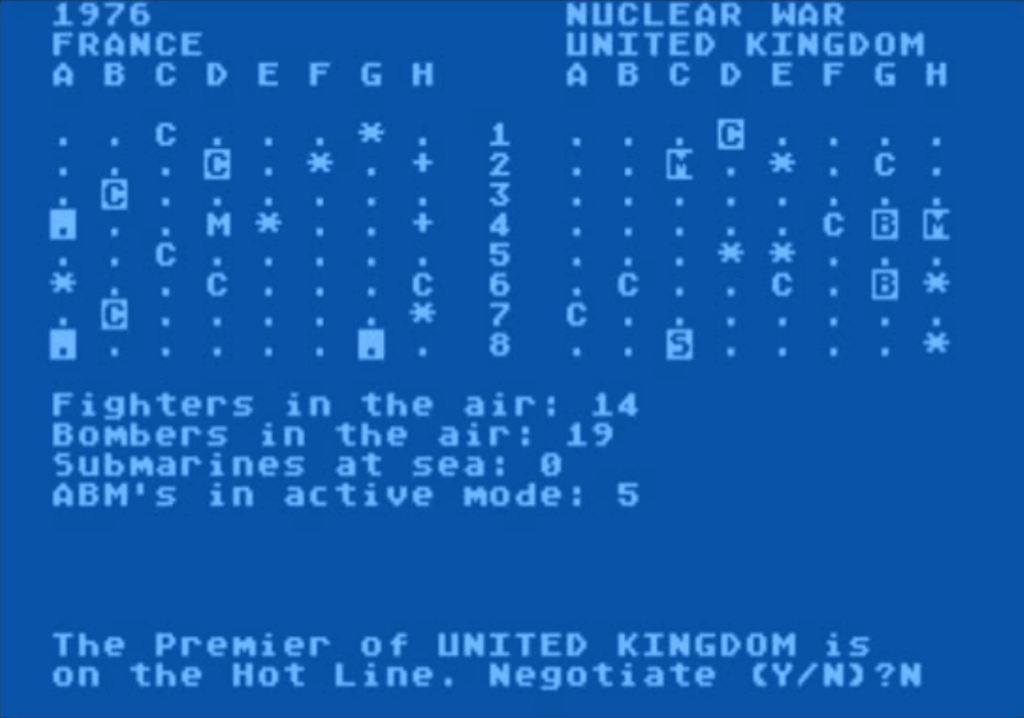
That’s a strong NON from me : the missiles will land even after the peace is signed, which would leave me with maybe 4 cities, whereas as far as I know the Brits still have their 8 starting cities. In addition, I still have numerous bombers and fighters, so I am confident I will prevail if I play the long game. What’s a few dozen million deaths when you can tell the British Premier to take a hike !
Consequently :

Well, there are no more known military targets in UK, though I am myself down to my last missile silo. Well, cities it is then :
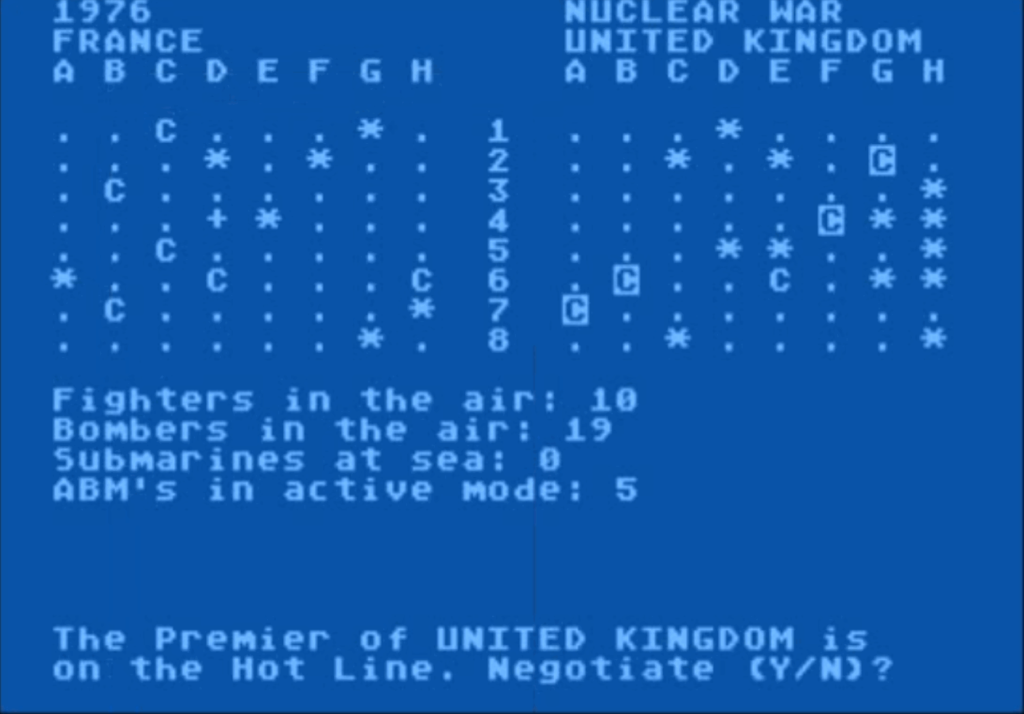
At this point I believe we both are out of missile silos, so it is time for the bombers to shine.
The British bombers arrive first, but they are all shot down.

Sadly, my first wave of bombers don’t do much better, and I am surprised to be on the receiving end of more missiles, possibly from submarines :
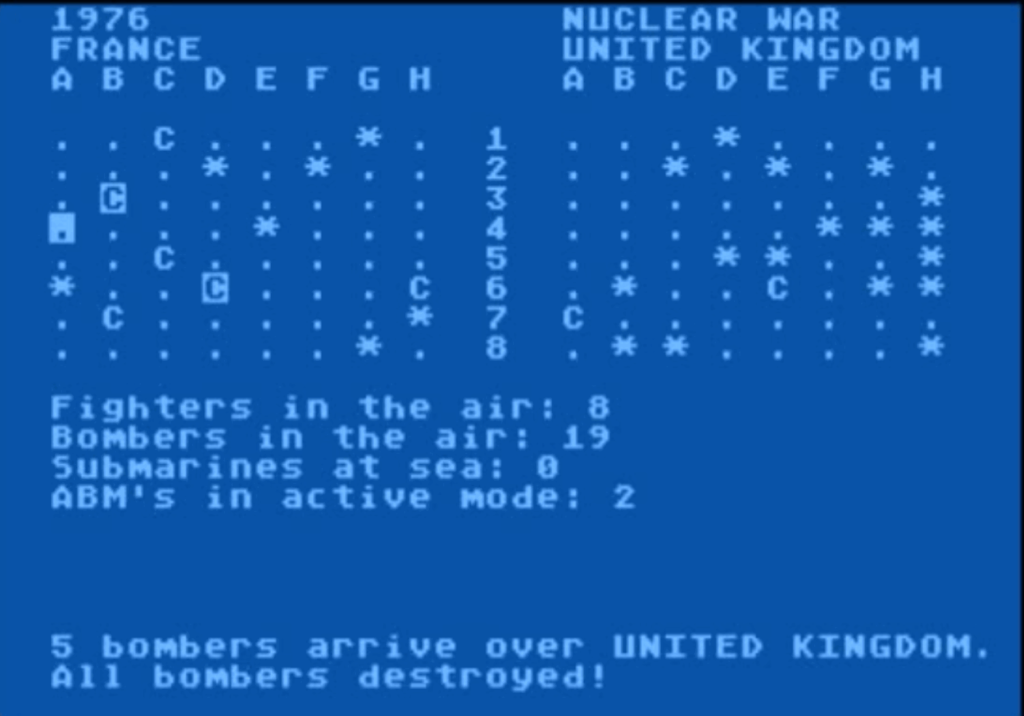
The situation looks more and more dire as more missiles are heading toward my cities, until some of my bombers finally pass through :
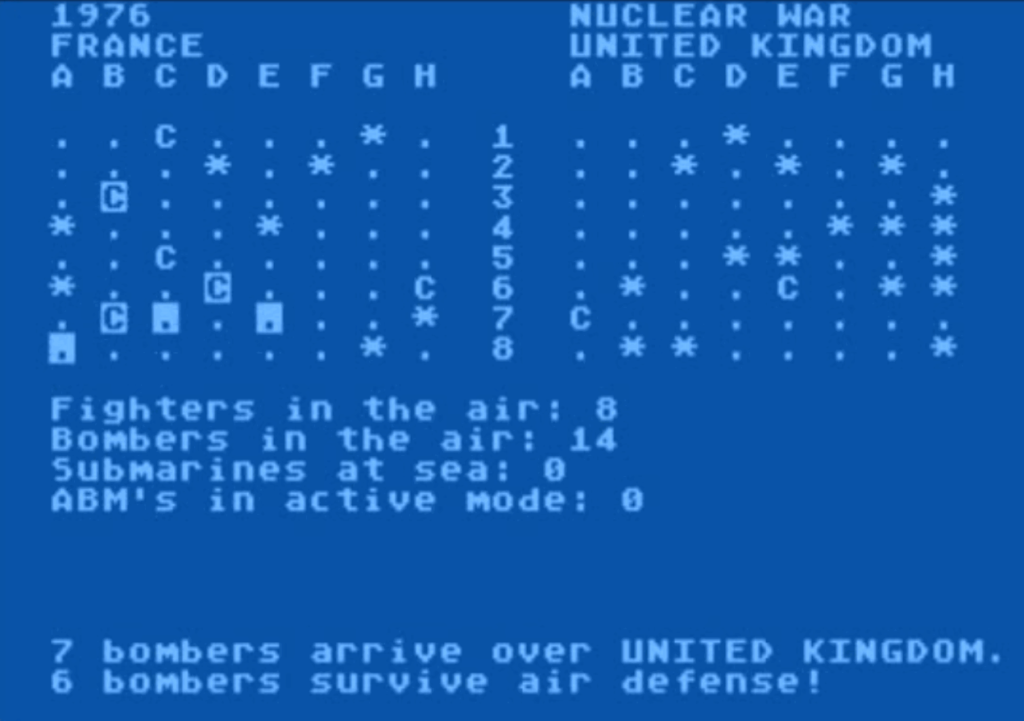
The Premier calls again, but a peace treaty would stop my bombers, not his missiles, so my position does not change.
My bombers do their ghastly job, and all the British cities that matter are destroyed.
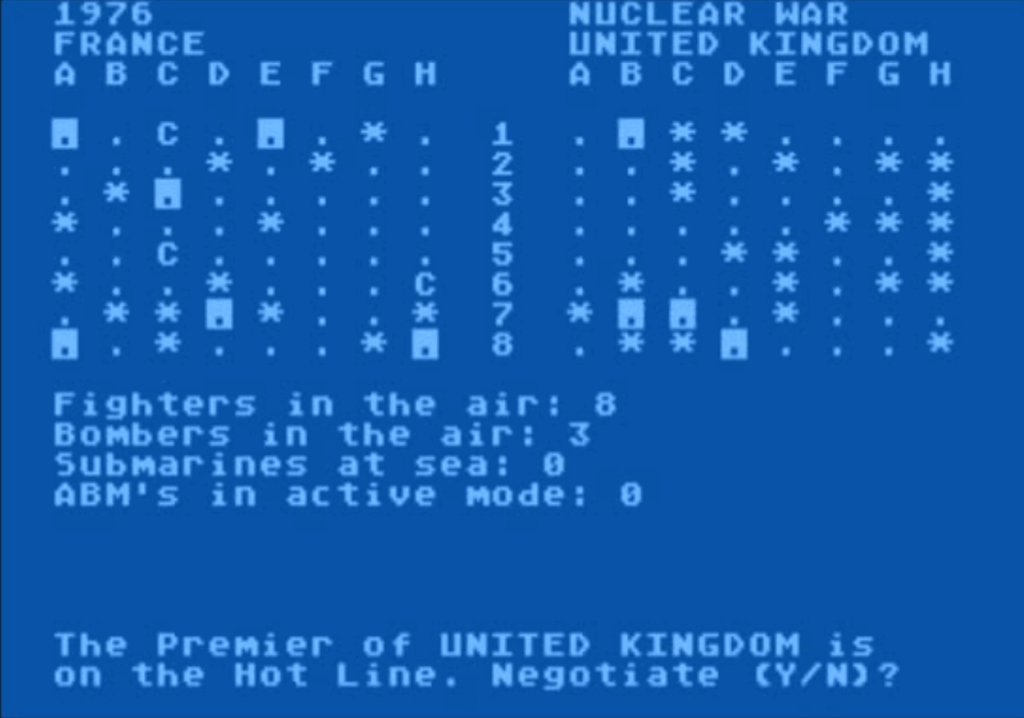
The British are still sending missiles, but clearly they have no idea where my last cities are.
And finally, there are no more nuclear weapons around. Out of 144 million starting inhabitants for both countries, France still has 73 and UK is down to 34. It is a strategic victory for France.

Cities are worth 11 million people and the other tiles 1 million, which means my bombers did their job in destroying that one British city I had not detected.
Ratings & Review
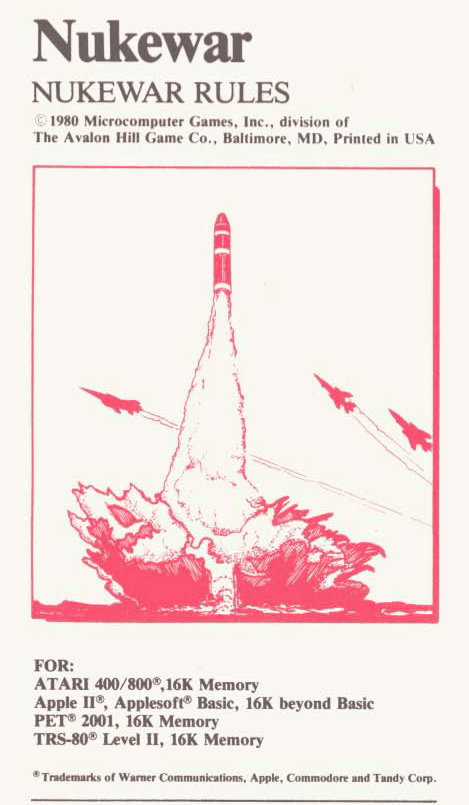
NukeWar by Avalon Hill, USA
First release : Summer 1980 on Apple II, Commodore PET, TRS-80
Tested on : Atari emulator
Total Hours Tested : 2
Average duration of a battle : 5-10 minutes
Difficulty: Trivial (0/5)
Would recommend to a modern player : No
Would recommend to a designer : No
Final Rating: 20/100
Unlike the three other Avalon Hill summer 1980 wargames, NukeWar does not pretend to be realistic in any way, and certainly it would not have attracted the typical grognard player, but I certainly had fun with it.
A. Settings & Aesthetics
The game is in no way realistic – you could very well call your country “Byzantium” and face “The Wizard of Oz“, nonetheless the game has a successful “design for effect” giving each element of the nuclear triad realistic strengths and weaknesses.
Of course, no more graphics than in the other Avalon Hill games.
Score : 3/20
B. UI , Clarity of rules and outcomes
The UI is super clear, but also annoying. Positioning the bases on the map is tiresome and has very little impact on the game (you just want to avoid putting two bases next to each other in case enemy missiles miss one of them but hit the other) – it could have been automated easily. In addition, when the war triggers late in the game and the player went heavy on missile silos, there can be a LOT (100+) of coordinates to input, which is even more tiresome.
The rules are not as clear as they could be : I am still not clear whether submarine missiles can be intercepted, I have had cases where my anti-ballistic missiles did not even try to intercept anything, and the rules concerning which nuclear warheads are stopped in case of peace are never explained anywhere.
Score : 4/20
C. Systems
As simple as the game is, it works.
Peace time can be considered as the “strategic” layer. As said above, the positioning is irrelevant, but the player really chooses a strategy when allocating between the various options, strategy that can also depend on what is spotted.
In my After Action Report, I used a lot of bombers, but in other tests I also won by building only missile silos while spying every turn, quickly found the eight enemy cities, declared war in 1970 or shortly thereafter (no ABM for my enemy !) and target the enemy cities first,

The war time is the “tactical” layer, and how you are going to approach depends a lot on how you played your peace time. Sadly this part disappoints as it is too dependent on randomness : randomness on the automatic activations, and randomness on the number of planes/missiles/ABM each activation gives : the spread goes from 1 to 8 which is way too large.
The game would have been better with some control not only on the activation of the sites themselves, but also on when the bombers/submarines attack, which sites your ABM are protecting, etc… You can find yourself in a situation where your bombers arrive on their targets very early, only destroy enemy sites you knew about, and now you have to aim your missiles randomly.
Last item of note : if you declare war while the enemy is not spying, you get a decisive first strike . Late game those are absolutely game-winning, but since whether the AI will spy or attack or just build-up is random, by the second half of the game you pretty much have to spy every turn.

Score : 5/20
D. Scenario design & Balancing
The starting scenario is always the same, except the year (which has an impact on how fast submarines and ABM become available), the game is pretty abstract and I would have love more customization options.
With a game that is so simple and “random” from the moment the war starts, it is hard to talk about balancing ; in any case after testing around 2 hours I consistently beat the AI even when if I am forcing myself never to start the war – the only exceptions being when I have a very unlucky opening of said war (eg my activation gives me 3 missiles, while 15 missiles are coming my direction).
Score : 3/20
E. Fun and Replayability
The game is actually very fun at the beginning, it has its rewarding moments and you get to test several strategies.
Replayability is not huge though as after one hour you know how to beat the AI consistently, and after two hours I feel like I have done everything there is to do in this game.
Score : 5/2
F. Final rating
20/100 – making it the best of the four Avalon Hill games, and indeed I had the most fun with this one.
I feel that what the game is really missing is a multiplayer mode. Second-guessing when the other player is going to attack would have been so intense.
Contemporary reviews
With a theme less evocative than the Bismarck or Midway, Nukewar was released totally unnoticed, only being reviewed at the same time as the other Avalon Hill games and with few specific comments.
It received a few more reviews with its Commodore 64 in 1983, and then was totally forgotten for years – even the 1993 Computer Gaming World wargame retrospective did not mention it (the list is about games covering conflicts “from 1900 to 1950”, but come on B-1 Nuclear bomber is there). It was therefore a most surprising guest in the 1996 Computer Gaming World list of the “150 best computer games of all time“. Sure, it was only in 135th position, but it is in good company : Heroes of Might and Magic I is 133rd, Master of Magic 141st and Ultima III 144th.